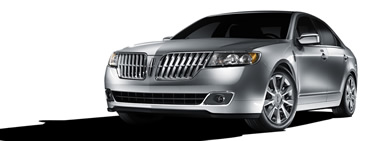|

Lincoln MKS and MKZ
Review: What is a Lincoln? Henry Leland, who had worked closely with
Ford very early on, and later founded Cadillac, founded the brand, named
for the 16th president, in 1917. Lincoln originally built luxury
vehicles, but ran into financial trouble, and Ford acquired them in
1922.
The first Continental,
developed by Henry Fordís son, Edsel, was a sensation when it arrived in
1939. After World War II, new Lincolns were stylish big brothers to the
Ford and Mercury offerings. In the mid 1950s the revived Continental II
was stylish, but sold poorly. Perhaps the most memorable Lincoln of the
last 50 years is the 1961 limousine that President Kennedy was
assassinated in on November 22, 1963.
Over the years Lincoln
has offered a succession of large, comfortable, luxurious sedans, the
personal luxury Mark series, and has had recent success with the
Navigator SUV. They have experimented with other vehicles, from the
midsize 1970ís Versailles to the mysterious Mark LT pickup truck. And
through it all, the full-size rear-wheel-drive Town Car has satisfied
livery providers year after year.
Today, Lincolnís future
is riding on two new sedans, the MKS and MKZ. The full-size MKS is
slated to be Lincolnís flagship model, while the midsize MKZ offers much
of the upscale content in a smaller, less expensive format. I tested the
cars back-to-back recently and they are both quite impressive.
The MKS shares its
underpinnings with the new Ford Taurus while the MKZ rides on the
smaller Ford Fusion platform. This is not a bad thing, and there are
many ways to tell youíre not in a Ford, from the look, to the
accommodations, to the presence of lots of Lincoln badging.
The MKS stretches 204.1
inches on a 112.9-inch wheelbase. Thatís full-size today. Compare that
to the 1961 Continental, which, at 212.4 inches long on a 123-inch
wheelbase, was actually shortened by nearly two feet from the humongous
1960 model.
While the MKS weighs
4,276 pounds, the old car was just a little under 5,000. The MKS feels
plenty big, but with that extra ten inches of wheelbase, the Ď61 enjoyed
tremendous limo-quality rear legroom.
If you want a more
compact package, the MKZ stretches 189.8 inches on a 107.4-inch
wheelbase. This is todayís midsize car, around or slightly larger than
an Audi A4 or a BMW 3 Series.
What upgrades a Ford
into a Lincoln? The comfortable seats in both of my cars were
leather-covered and Lincoln logo embossed, with 12-way adjustment in the
MKS and 10-way in the MKZ. They offer heating and cooling too. Also, I
like the chrome, nicely rendered, in a Mercedes-Benz kinda way.
Especially in the larger, fancier MKS, the chrome glistens everywhere.
On the outside, both
cars feature Lincolnís new tall, winged grille that borrows from the
classic í39. Overall, the cars feel pleasant and modern, with a little
nod to Lexus.
Under the hood of my
Tuxedo Black MKS was Fordís new 3.5-liter Ecoboost engine, which
generates V8 power with V6 fuel economy. With 355 horsepower on tap, it
certainly hits it mark on the power. EPA numbers are 17 City, 25
Highway, and I averaged 19.0 mpg.
The smaller, 480-pound
lighter MKZ, also in Tuxedo Black, featured the veteran 3.5-liter
Duratec V6, and with 263 horsepower, was rated at 17 City, 24 Highway. I
averaged 19.5 mpg with it. So, the V8 vs V6 case is made.
The MKS came with the
Active Park Assist system. You simply press a little button on the
center console and then drive slowly along the street. When the car
senses a large enough space it asks you to stop and engage reverse.
Then, you let go of the wheel, and pressing the gas yourself, the car
backs into the spot, virtually perfectly every time, ending up one or
two inches from the curb. It feels strange to press the gas with your
hands off the wheel, but it works great.
The MKS also had
adaptive cruise control, which follows the car in front at a set
distance, braking and accelerating to keep up. Also, with the Collision
Warning system, if you are closing in quickly on the car ahead, a red
strip of light flashes on your dash top. Both of my test Lincolns had
all-wheel drive, something prominently featured in Audis. Itís a
differentiator, certainly, and welcome here.
The MKS starts at
$47,760 and mine ended up with an MSRP price of $53,930 with a few
options, including a cool dual-panel moonroof and a navigation system.
The MKZ starts at $36,005; mine topped out at $43,245. Those are both
very competitive prices.
Will enough buyers
accustomed to buying European and Japanese luxury brands consider a
Lincoln? The content and appearance are approaching world class, and the
alphanumeric new names sound like those of European cars. Time, and
advertising, will tell.
By Steve Schaefer ©
AutoWire.Net - San Francisco
Lincoln MKS and MKZ
Reviews provided by: Tony Leopardo © AutoWire.Net. ďTony the Car GuyĒ
is an automotive writer, editor and publisher in the San Francisco Bay
Area. If you have a question or comment for Tony send it to
TonyLeo@pacbell.net or visit AutoWire.Net at
www.autowire.net - And remember: ď You Are What You Drive Ē

Lincoln Home Page
Column Name: Lincolnís
future is riding on two new sedans
Topic: The 2010 Lincoln
MKS and MKZ
Word Count: 931
Photo Caption: The
2010 Lincoln MKS and MKZ
Photo Credits: Lincoln
Internet Media
Series #: 2010 - 21
Download
the Microsoft Word version here:
2010 Lincoln MKS and MKZ
Download the Original Image File here:
2010 Lincoln MKS and MKZ


|
